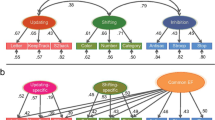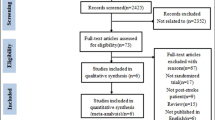Abstract
Brain damaged and normal subjects were tested on their ability to transfer information of varying complexity across sensory modalities. Subjects without neurological damage were compared to subjects with left and right hemisphere lesions. Tasks varied in complexity from simple matching of Morse code patterns within a sensory modality to cross-modal transfer across sensory modalities. The results confirmed that cross-modal matching ability is significantly impaired in subjects with posterior left hemisphere lesions, whereas subjects with lesions in other areas of the brain show minimal deficits in cross-modal abilities. The results are interpreted to support a multimodal basis for complex intellectual function. Language is hypothesized to be one response capability that depends on intact cross-modal functions, with the angular gyrus region of the dominant hemisphere forming an anatomical basis.
Similar content being viewed by others
References
BELMONT, L., BIRCH, H.G., & BELMONT, I. 1968. Auditory-visual intersensory processing and verbal mediation. Journal of Nervous and Mental Diseases, 147, (6), 562–569.
BIRCH, H.G., & BELMONT, L. 1964. Auditory-visual integration in normal and retarded readers. American Journal of Orthopsychiatry, 34, 852–861.
BIRCH, H.G., & BELMONT, L. 1965. Auditory-visual integration, intelligence and reading ability in school children. Perceptual Motor Skills, 20, 295–305.
BLANK, M., ALTMAN, L.D., & BRIDGER, W.H. 1968. Cross-modal transfer of form discrimination in preschool children. Psychonomic Science, 10, 51–52.
BLANK, M., & BRIDGER, W.H. 1964. Cross-modal transfer in nursery school children. Journal of Comparative and Physiological Psychology, 66, 277–282.
BLANK, M., & BRIDGER, W.H. 1966. Deficiencies in verbal labeling in retarded readers. American Journal of Orthopsychiatry, 36, 840–847.
BURTON, D., & ETTLINGER, G. 1960. Cross-modal transfer of training in monkeys. Nature, 186, 1071–1072.
BUTTERS, N., & BRODY, B.A. 1968. The role of the left parietal lobe in the mediation of intra-and cross-modal associations. Cortex, 4, 328–343.
BUTTERS, N., BARTON, M., & BRODY, B.A. 1971. Role of the right parietal lobe in the mediation of cross-modal associations and reversible operations in space. Cortex, 7, 261–267.
CRITCHLEY, M. 1953. The parietal lobes. London: Arnold.
GAYDOS, H.G. 1956. Intersensory transfer in the discrimination of form. American Journal of Psychology, 69, 107–110.
GESCHWIND, N. 1964. The development of the brain and the evolution of language. Monograph Series on Languages and Linguistics, No. 17. 155–169.
GESCHWIND, N. 1965a. Disconnexion syndromes in animals and man. Brain, 88, 237–294.
GESCHWIND, N. 1965b. Disconnexion syndromes in animals and man. Brain, 99, 585–644.
LURIA, A.R. 1966. Human brain and psychological processes. New York: Harper and Row.
LURIA, A.R. 1970. The functional organization of the brain. Scientific American, 222, 66–79.
REITAN, R. 1960. The significance of dysphasia for intelligence and adaptive abilities. Journal of Psychology, 50, 355–376.
REITAN, R.M., & DAVISON, L.A. 1974. Clinical neuropsychology: Current status and applications. Washington, D.C., Winston and Sons.
SEMMES, J., WEINSTEIN, S., GHENT, L., & TEUBER, H.L. 1954. Performance on complex tactual tasks after brain injury in man: Analysis of locus of lesion. American Journal of Psychology, 67, 220–240.
STEPIEN, L.S., & CORDEAU, J.P. 1960. Memory in monkeys for compound stimuli. American Journal of Psychology, 73, 388–395.
WILSON, M., & WILSON, W.A. 1962. Intersensory facilitation of learning sets in normal and brain operated monkeys. Journal of Comparative and Physiological Psychology, 55, 931–934.
WILSON, W.A., & SCHAFFER, O.C. 1963. Intermodality transfer of specific discriminations in monkeys. Nature, 197, 107.
YEHLE, A.L., & WARD, J.P. 1969. Cross-modal transfer of a specific discrimination in the rabbit. Psychonomic Science, 16(5), 269–270.
Author information
Authors and Affiliations
Rights and permissions
About this article
Cite this article
Zinkus, P.W. Intra- and Cross-Modal Transfer in Relation to Brain Dysfunction and Language Disorder. Psychol Rec 29, 379–387 (1979). https://doi.org/10.1007/BF03394626
Published:
Issue Date:
DOI: https://doi.org/10.1007/BF03394626




